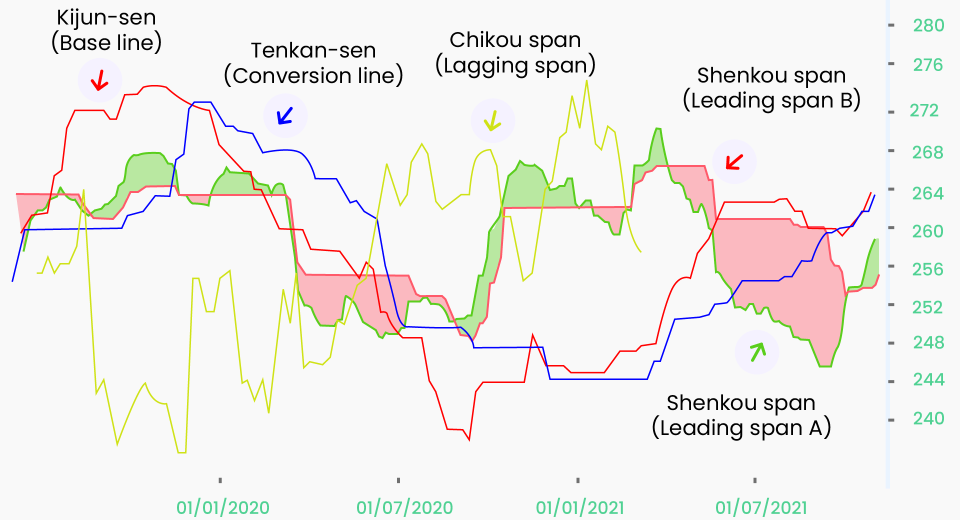5 Types of Moving Average Indicators Traders Should know

Image source: https://immediate.net
Did you know that traders who use charts to analyse price movements without using technical indicators are called “chartists”? Charts have a story to tell, but to understand the language of their narration, you need technical indicators. These interpret the story in the form of easy-to-understand signals that help you identify entry and exit opportunities.
One of the most used indicators is Moving Average. The reason for its popularity is that it smooths out the price data, removing the impact of short-term and random fluctuations, to help identify broader trends. Moving Average is popular among beginners and seasoned traders alike. It’s simple for beginners to understand, while pairing well with most other technical indicators for experienced traders to prepare their favourite trading toolkit.
Did you know?
The indicator is called Moving Average because it keeps recalculating and updating the average price as the price of an asset fluctuates. So, it’s a lagging indicator, as it trails the asset’s price action to highlight the direction of the trend that forms over a specified timeframe.
#1 – Simple Moving Average (SMA)
This is a straightforward indicator that sums the latest price movements and divides the total by the number of time periods.
How to calculate: SMA = (AP1 + AP2 + AP3 ………. APn) / n
Here, AP is the average price in the period n, and n is the number of periods.
While traders can use SMAs for different types of prices, like highs, lows, open, and close, usually the closing price is used. This technical indicator is typically used to identify support and resistance levels. So, the 20-day SMA refers to the average of closing prices over the past 20 trading days.
#2 – Weighted Moving Average (WMA)
This gives a higher weight to the latest prices, as these play a more meaningful role in determining future price movements than historical data points. SMA gives weightage to all price fluctuations in a chosen timeframe.
How to calculate: First, create a list of the closing prices of the asset over the chosen time period. Then determine the weights of each of these by dividing the day number by the sum of the days. For instance, in the table below, the sum of the days is 1+2+3….+10, which is 55. Then multiply the weight with the closing price of the asset.
| Day | Weight | Closing Price of XYZ Stock | Weighted Average |
| February 1 | 1/55 | $100 | 1.82 |
| February 2 | 2/55 | $102 | 3.71 |
| February 3 | 3/55 | $99 | 5.40 |
| February 4 | 4/55 | $98 | 7.13 |
| February 5 | 5/55 | $99 | 9.00 |
| February 6 | 6/55 | $97 | 10.58 |
| February 7 | 7/55 | $98 | 12.47 |
| February 8 | 8/55 | $99 | 14.40 |
| February 9 | 9/55 | $100 | 16.36 |
| February 10 | 10/55 | $101 | 18.36 |
The WMA is obtained by adding up the weighted averages. In the above, the WMA is 1.82 + 3.71 + 5.40… + 18.36 = $99.24.
#3 – Exponential Moving Average (EMA)
This also assigns a higher weight to the most recent prices, but the gap between the weights is not consistent. The rate of decrease between one price and its preceding price is exponential.
How to calculate: First, calculate the multiplier for weighting the EMA with the formula:
Multiplier = [2 / (Selected Period + 1)]
So, for a 10-day EMA, the multiplier will be [2 / (10+1)] = 0.1818, while for a 20-day EMA, the multiplier will be [2 / (20+1)] = 0.0952.
Then, the current EMA is calculated with the formula:
EMA = [Closing Price – EMA (Previous Period)] x Multiplier + EMA (Previous Period)
#4 – Double Exponential Moving Average (DEMA)
This uses a double-smoothed EMA, giving even more weightage to the most recent prices. It is said to greatly reduce the lag results that crop up when using the EMA and is most frequently used by scalpers or when the market is highly volatile.
How to calculate: First, the EMA is calculated. Then, an EMA calculation is done again, using the result of the first EMA as a function in the formula.
DEMA = [2 ∗ EMA(n)] – [EMA * EMA(n)]
#5 – Triangular Moving Average (TMA)
This uses a double smoothed SMA, which means the price data is averaged twice. This indicator is often used to identify changes in the direction of the trend.
How to calculate: TMA = (SMA1 + SMA2 + SMA3 + . . . . . . + SMAn) / n
Trading Strategies Using Moving Averages
The good news is that you don’t need to make these complex calculations. Moving Average indicators can be applied to MT4/MT5 charts with a simple drag and drop.
Interpreting Moving Averages
Irrespective of the type of moving averages:
- When the latest price action is mostly above the moving average line, it signals a general uptrend.
- If the price action is broadly below the moving average line, it indicates a downtrend.
When using moving averages with different time periods:
- If the shorter-term MA lies above the one with a higher period (for instance, the 10-day MA lies above the 20-day MA), it confirms the uptrend.
- The shorter-term MA lying mostly below the longer-term MA, confirms the downtrend.
Moving Average (MA) Crossover
A price crossover is said to occur when the asset price crosses above or below a moving average line, signalling a potential change in trend.
- The asset price rising above the MA line generates a bullish signal.
- The asset price falling below the MA line is a bearish signal.
Double MA Crossover
- If the shorter-term MA crosses above the longer-term MA, it means the trend is shifting up and is a buy signal. This is known as a golden cross.
- If the shorter-term MA crosses below the longer-term MA, it indicates that the trend is moving down. It is considered a sell signal and is called a death cross.
Triple MA Crossover
This involves plotting three different MAs with different time periods, which helps eliminate false signals. The first two MA lines are used to determine whether a deviation of the price from the trend is indicative of a reversal of the trend or simply a momentary fluctuation. The third MA line is used to confirm or deny the signals.
Apart from these, the Moving Average Convergence Divergence (MACD) is another popular technical indicator. This considers the difference between a short-term EMA and a longer-time one, typically calculated using the asset’s closing prices. The crossover of the MACD with the signal lines indicates possible entry and exit points.
Disclaimer:
All data, information and materials are published and provided “as is” solely for informational purposes only, and is not intended nor should be considered, in any way, as investment advice, recommendations, and/or suggestions for performing any actions with financial instruments. The information and opinions presented do not take into account any particular individual’s investment objectives, financial situation or needs, and hence does not constitute as an advice or a recommendation with respect to any investment product. All investors should seek advice from certified financial advisors based on their unique situation before making any investment decisions in accordance to their personal risk appetite. Blackwell Global endeavours to ensure that the information provided is complete and correct, but make no representation as to the actuality, accuracy or completeness of the information. Information, data and opinions may change without notice and Blackwell Global is not obliged to update on the changes. The opinions and views expressed are solely those of the authors and analysts and do not necessarily represent that of Blackwell Global or its management, shareholders, and affiliates. Any projections or views of the market provided may not prove to be accurate. Past performance is not necessarily an indicative of future performance. Blackwell Global assumes no liability for any loss arising directly or indirectly from use of or reliance on such information herein contained. Reproduction of this information, in whole or in part, is not permitted.




